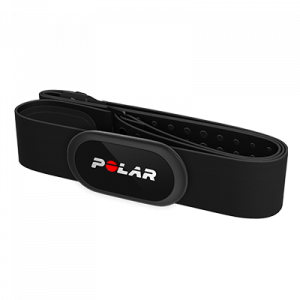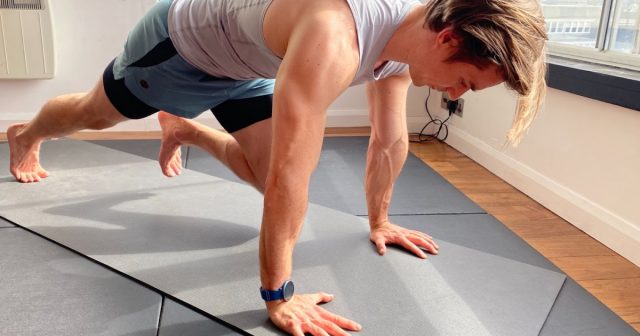A heart rate training plan is all about balance. By creating a workout schedule with some intense days and some gentle days, you will maximize your results while also lowering the risk of strain or injury. This isn’t a ‘no pain, no gain’ approach but rather a ‘work smarter, not harder’ strategy. Here’s how to find the right tech for you and create a training plan using heart rate zones, low-heart rate, or HIIT.
Heart rate-based training tools
Before you can begin training by heart rate, you’ll need the right tech to measure it with. This way, you’ll be constantly aware of your beats per minute (BPM) – the essential metric for this type of training.
There are a couple of different options when it comes to heart rate monitors. You can wear one on your chest, your arm, or your wrist. So how do they differ?
The classic chest strap uses an electrocardiogram (ECG) to measure your heart rate. It can then be connected to a combination of devices, including your sports watch, bike computer, fitness app, and/or gym equipment to give you a real-time measurement of your heart rate.
The arm strap works in a similar way with your devices but uses optical heart rate tracking instead – just like the fitness watch on your wrist. Your watch differs from the chest and arm straps in that you don’t need any other devices because all the information you need for checking your heart rate is right there on the screen.
WHAT ARE HEART RATE ZONES?
So now you have your tech sorted, what can you do with your these measurements? Using your maximum heart rate (MHR), you can calculate the optimal target heart rate zone for each exercise session according to your goals. Often referred to as ‘zone training’, you will use your heart rate monitor to ensure you’re working out at the right BPM but never going over it for that day.
There are different five heart rate zones, which correspond with a certain percentage of your MHR. From ‘very light’ (50-60% of your MHR) to ‘maximum’ (90-100% of your MHR), each zone has a different effect on your body when you exercise in it.
Creating Your heart rate training plan
So now you know what your heart rate zones are, it’s time to create your training plan. This is something you can easily do yourself, based on the types of workouts you enjoy.
Your training plan should include a mixture of different cardio workouts that cover each of your heart rate zones. Take the opportunity to think about what you want out of each week and create a mix that will motivate you, especially when you start to see the results.
Unsure how much time you should spend working out each week? The American Heart Association recommends that adults aim for at least 150 minutes per week of moderate-intensity aerobic activity or 75 minutes per week of vigorous aerobic activity, ideally a blend of both. This works out to be a very achievable 22 minutes per day – but you can always do more.
Even if you’re only interested in one type of training, such as running, it’s still important to include this variety of workouts to supplement your practice. Add some yoga or drill days to your training plan to enhance your running by building strength and improving your mobility.
The best thing about having a varied training plan is that you can always swap your days around based on how you’re feeling. Life doesn’t always go according to any plan, so if you haven’t had a great night’s sleep you can do some slow stretches in zone 1 or 2. Having a busy day? Swap your long run for a quick HIIT session in zone 4.
CALCULATing YOUR LOW HEART RATE FOR TRAINING
Want to try low heart rate training? Maffetone’s formula is 180 minus your age (for example, 180-30 years=150 BPM). The idea is that you start at whatever pace you need to go to maintain this heart rate and over time, your pace will increase but your heart rate won’t.
There are a few amendments to this calculation. For example, if you have a cold or flu more than twice a year, or are asthmatic, you should subtract another five from your low heart rate calculation. Same if you have a minor injury or find you’re not improving from your training. If you’re recovering from an operation, a major illness, are on medication or feeling burned out from overtraining, you should subtract 10 from your calculation.
How to use your heart rate in HIIT
The idea behind HIIT is that you workout at a high intensity (as the name suggests) and then a low intensity. But how do you know exactly what your high and low levels are? This is where knowing your MHR is key. Once you have estimated this, you can easily calculate your heart rate zones, which means you’re ready to get to work.
Start with a warm-up in zone 2 (60-70% of your MHR) for the first five minutes of your workout. Then up the intensity to zone 4 (80-90% of your MHR) for at least 30 seconds, but no more than a few minutes. Then drop down to zone 1 (50-60% of your MHR) for a recovery phase of about three minutes. Now repeat this intensity and recovery cycle for at least 20 minutes.
Using a heart rate monitor is an easy way to track which zone you’re in. If you don’t have one, then an alternative option is to keep an eye on your breathing. If you’re able to talk while doing your intensity workout, then you probably need to take it up a notch till you feel short of breath. Don’t train too hard or for too long though – not only will you end up exhausted and sore, you won’t get out as much as you put in.
If you liked this post, don’t forget to share so that others can find it, too.
Or give it a thumbs up!
I like this article
Please note that the information provided in the Polar Blog articles cannot replace individual advice from health professionals. Please consult your physician before starting a new fitness program.






